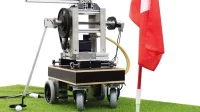Golfi is a golf robot that uses a Kinect camera and a neural network to calculate green shots.
Robots can do the craziest things. And this is in all areas. Robots kicking the ball on the fairway aren’t really new, but a robot that can play with nuances on the green presents a much bigger challenge. Researchers at the University of Paderborn in Germany have just managed to create such a machine, nicknamed the Golfi, which uses a neural network to know how to place a shot and how hard to hit the ball to get it into the hole from anywhere in the field. green.
Golfi golfer robot uses Kinect camera and neural network
The robot takes a full view of the greenery using a Microsoft Kinect 3D camera and simulates several thousand random shots taken in different locations. This takes into account many factors, such as the resistance of the lawn, the weight of the ball and the speed of departure. Graduate student Annika Junker told IEEE Research that it takes five minutes to practice golf on simulated holes, compared to the 30-40 hours the team had to feed the system with data extracted from real shots.
Once Golfi has determined that a shot needs to be made, he moves towards the ball and uses his built-in set, with a stick of course, to start the action. However, the robot does not put the ball into the hole every time. Annika Juncker explains that the robot achieves this with a 60 to 70% success rate. It’s still better than most golfers. And Golfi won’t swing his fury mace if he misses!
calculate his shots on the green
At the same time, Golfi sometimes rolls the ball and changes position. The researchers only tested their creation in the lab, not in real-world conditions, with greenery that can be very different, and very thin terrain, which obviously poses a major problem for a system that uses only a viewing plane.
In any case, the researchers at the University of Paderborn did not aim to develop a robot that could compete with the PGA Tour professionals. However, they hope that the methods used for the Golfi can be reused for other robotic applications. “You can also transfer this to other problems where you would have knowledge of the system and you could model certain parts of it to get some data, but you can’t model everything,” explained Niklas Fittkau, also a doctoral student at the University of Paderbronn. and co-author of this article in IEEE Research.
In 2016, another robot named LDRIC had a hole in one during a PGA event, but on the fifth try.


